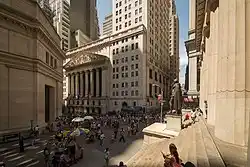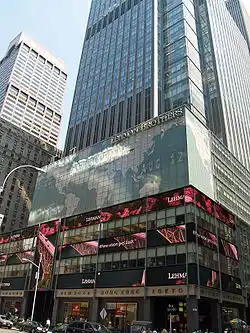
The Great Recession is the name given to the economic crash and downturn which affected the world economy from September 2008 onwards, lasting ultimately into the early 2010s, while the long-term impacts of the austerity imposed as a consequence of it have been felt even into the 2020s. It is termed the Great Recession to differentiate it from the Great Depression which occurred following the Wall Street Crash of 1929 that caused immense hardship for most of the first half of the 1930s. Like the Wall Street Crash and the Great Depression, the Great Recession was caused by a decade of speculative investment by global financial institutions and a catastrophic lack of regulation of western capitalist systems. These eventually resulted in a banking crisis across the western world in the autumn of 2008, in tandem with a collapse in the property market and financial contagion. Tens of millions people lost their jobs across the world, while the economies of most western countries went into recession, hence the name, the Great Recession. These events led to a general decline in migration as labor markets dried up and people stopped moving around as much for work reasons.[1]
Research your ancestors on MyHeritage
The Great Recession chronology of eventsThe Great Recession chronology of events

It is a well attested fact that modern capitalist economies go through cycles of years of economic growth, punctuated by fiscal crises and depressions every decade or so. Sometimes there are also speculative investment bubbles and eras where a lack of market regulation plays a role in creating economic chaos. These cycles were in evidence as soon as corporations, stock exchanges and other investment instruments in industry, all features of modern capitalism, first began to emerge in countries like England and the Dutch Republic in sixteenth and seventeenth centuries. For instance, the Dutch Republic had the Tulip mania of the late 1630s which created a ridiculous bubble in which tulip plants were selling for outrageous prices in Amsterdam and other cities.[2] The English had the South Sea Bubble over investment in the South Sea Company in the late 1710s.[3]
These economic peaks and valleys became ever more common in the nineteenth and twentieth centuries. However, most people only know of a few of them today. The Great Depression of the late 1920s and early 1930s is ubiquitous, as is the Dot.com Bubble of the late 1990s, though few have heard of the Railway Mania of the 1840s, the depression of the mid-1870s or the Panic of 1907. However, a century from now everyone will still know about the Great Recession, a fiscal crisis that has shaped the twenty-first century so far.[4]
The roots of the Great Recession lie in the 1980s when the governments of countries like the United States and the United Kingdom began deregulating Wall Street and the City of London. This was an era of economic growth after the stagnation of the 1970s and so it appeared to policy-makers that this deregulation had worked well. They therefore expanded it in the 1990s, buoyed also by the seeming triumph of western capitalism over communism at the end of the Cold War and talk of free market liberalism bringing about an end to traditional conflict and history. By the early 2000s, even light-touch regulation was being abandoned in favor of letting the financial industry operate in whatever way it wished.[5]
The problem with this approach was that financiers on Wall Street and other financial centers had begun devising new financial instruments like CDOs (collateralized debt obligations) in order to loan out money to people on generous rates whose financial security was highly questionable. This was achieved by disguising poorly-performing loans by chopping them up and mixing them in with good-performing loans. This practice fuelled an enormous property bonanza in the 2000s, particularly so between 2003 and 2007, something which would become known in the United States as the Subprime Mortgage Crisis that began in 2007.[6]
The Subprime Mortgage Crisis was what put the questionable financial practices employed by Wall Street and other financial centers for many years under the spotlight. As increasing attention was paid to the loan books of leading banks and financial institutions in the United States and across the European Union, it became apparent that across the western world these same institutions had abandoned any form of caution since the late 1990s and now had enormous loans on their books given out to individuals who could not pay them back. They had simply disguised this for many years by hiding the inability to pay these loans back through the use of CDOs.[7]

As with any economic crisis, once the inherent problems in the system were realized and confidence in it began to ebb away, the dominos started to fall very quickly. The tipping point was when it became apparent in September 2008 that two leading American financial institutions, Merrill Lynch & Co. and Lehman Brothers, were in grave trouble. Lehman Brothers was allowed to fail, although Merrill Lynch was acquired by the Bank of America. These events set off a chain reaction around the western financial and economic system that led to banks and economic systems in dozens of countries becoming distressed in the months that followed. Some were bailed out by sovereign nations and the cost of doing so was nationalized and passed on to taxpayers. Others were allowed to fail, the same as Lehman Brothers.[8]
The overall impact was enormous. The world economy contracted by 5% in 2009 as tens of millions of people lost their jobs, the construction industry was effectively shut down in most western countries and the entire western financial system was called into question. Many well-developed countries like Ireland, Greece and Portugal ended up insolvent and unable to pay their way or borrow money on the international bond markets, leading to bailouts by the International Monetary Fund and other institutions such as the European Central Bank. The price of these was the imposition of draconian austerity programs.[9]
The crisis lasted in its initial phase for the better part of half a decade, as many countries experienced economic contraction through 2009, 2010 and 2011. This meant that virtually the whole western world went into economic recession, defined as when a country has experienced two consecutive quarters of economic contraction. Indeed most countries were in economic depression, a more extended form of recession and economic contraction. However, the term 'Great Depression' was already in use to describe the era that followed the Wall Street Crash of 1929. Hence did the financial crash of 2008 and the years that followed become known as the Great Recession. The effects of it have been long-lasting, with many countries having poorly resourced state services over a decade and a half later on account of a lost decade of investment.[10]
Impact of the Great Recession on migration patternsImpact of the Great Recession on migration patterns
The Great Recession led to a general decline in migration. As jobs dried up and economic decline set in people stopped moving around to acquire jobs. This lack of labor mobility led to a period of decreased migration in the western world until the mid-2010s when countries started to recover.[11] Conversely, there was some mobility of a different kind as people moved from the worst impacted countries to nations which were less impacted. The Great Recession impacted the whole world, but it struck particularly strongly in North America and Europe. Therefore during the course of it many people began to migrate to countries where certain jobs were in greater abundance. A good example is Australia, where many construction workers from Europe, who found themselves completely out of work at home after the crash of 2008, temporarily moved to acquire employment in the lean years between 2009 and the mid-2010s.[12]
See alsoSee also
Explore more about the Great RecessionExplore more about the Great Recession
- Great Recession at History
- A Short History of the Great Recession at Forbes
- The Great Recession and its Aftermath at Federal Reserve History
References
- ↑ https://www.history.com/topics/21st-century/recession
- ↑ https://www.bbc.com/culture/article/20160419-tulip-mania-the-flowers-that-cost-more-than-houses
- ↑ https://www.historic-uk.com/HistoryUK/HistoryofEngland/South-Sea-Bubble/
- ↑ https://www.thoughtco.com/financial-panics-of-the-19th-century-1774020
- ↑ https://www.sciencedirect.com/science/article/pii/S1057521918303880
- ↑ https://insights.som.yale.edu/insights/inside-the-cdo-market-that-catalyzed-the-financial-crisis
- ↑ https://www.thestreet.com/dictionary/subprime-mortgage-crisis
- ↑ https://edition.cnn.com/2018/09/30/investing/lehman-brothers-2008-crisis/index.html
- ↑ https://www.ncbi.nlm.nih.gov/pmc/articles/PMC4952125/
- ↑ https://www.investopedia.com/terms/g/great-recession.asp
- ↑ https://www.ncbi.nlm.nih.gov/pmc/articles/PMC5959048/
- ↑ https://www.aph.gov.au/About_Parliament/Parliamentary_Departments/Parliamentary_Library/pubs/BriefingBook46p/LastRecession

